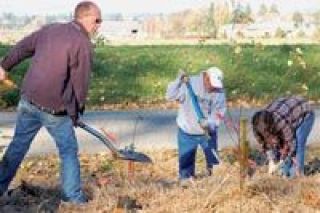STANWOOD Volunteers from the Stillaguamish Tribe of Indians and Stanwood High School planted more than 300 native trees and shrubs from the Tribes BankSavers nursery at Hatt Slough Oct. 31, through the Department of Natural Resources Adopt an Access program.
The Tribe officially adopted the Hatt Slough boat launch on Marine Drive in Stanwood, Feb. 14, after Stillaguamish Tribal Chair Shawn Yanity learned of the Adopt an Access program through Brad Otto, of the Washington Department of Fish and Wildlife, during their participation in the cooperative elk capture on Mount St. Helens the preceding fall.
According to Yanity, he and Otto agreed such an adoption could act as a positive symbol of the ever-improving working relationship the Tribe and the Department of Fish and Wildlife have developed over the past several years.
Yanity asserted the importance of Hatt Slough to the Tribe, not only because the Tribe once had villages in the surrounding area, but also because it still makes use of the Hatt Slough access on a regular basis to launch boats for water quality testing and juvenile Chinook estuary studies.
Since adopting the seven-acre site, the Tribe has organized bimonthly work parties to clean up trash and maintain the site, clearing out approximately 2,000-square-feet of blackberries and other invasive species from the site in the process, while staff members from the Stillaguamish Natural Resources Department have also made an effort to pick up litter during their visits to the site.
WDFW Regional Lands Agent Kye Iris characterized the 17-member volunteer planting Oct. 31 as a big step above an beyond the obligations of the Adopt an Access program, especially since BankSavers has provided 2,300 native plants, including western red cedar, Douglas fir, and shore pine, to be planted through November, until all of the plants are in the ground.
Theyve made a long-term investment to maintain the site, Iris said.
This really helps us out, said WDFW Access Area Manager Robert Lantiegne, whose duties cover 85 such access sites, in five counties across the state, that have to be taken care of on a regular basis, only four of which are currently adopted.
Were just happy to serve as stewards of this area, Yanity said.
Stillaguamish Tribe plants trees at adopted Hatt Slough boat launch
STANWOOD Volunteers from the Stillaguamish Tribe of Indians and Stanwood High School planted more than 300 native trees and shrubs from the Tribes BankSavers nursery at Hatt Slough Oct. 31, through the Department of Natural Resources Adopt an Access program.








